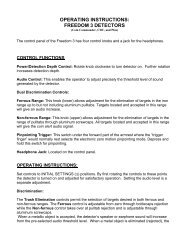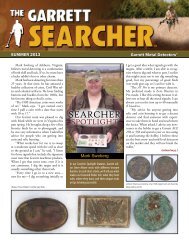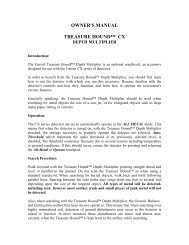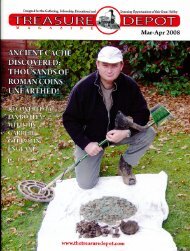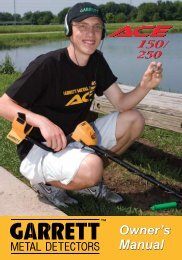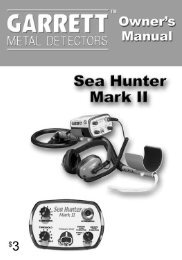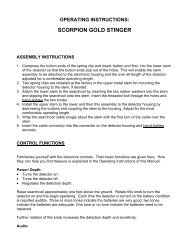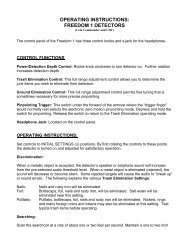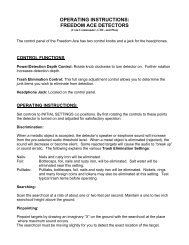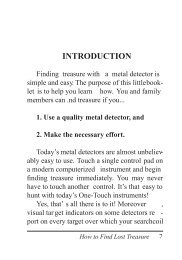Sea Hunters XL500 and XS500 VLF - Garrett
Sea Hunters XL500 and XS500 VLF - Garrett
Sea Hunters XL500 and XS500 VLF - Garrett
Create successful ePaper yourself
Turn your PDF publications into a flip-book with our unique Google optimized e-Paper software.
OPERATING INSTRUCTIONS:SEA HUNTERS <strong>XL500</strong> AND <strong>XS500</strong> (<strong>VLF</strong>)MODEL DESCRIPTIONSTwo <strong>Sea</strong> Hunter underwater metal detector models are produced by <strong>Garrett</strong> Electronics.These two models, <strong>XS500</strong> <strong>and</strong> <strong>XL500</strong>, are basically the same electronically. They differ insearchcoil type, mechanical configuration, <strong>and</strong> in the manner in which they are used.CAPABILITIESThe capabilities of the <strong>Sea</strong> Hunter are many. In fact, no other underwater detector canperform all the tasks the <strong>Sea</strong> Hunter is capable of performing. The <strong>Sea</strong> Hunter can beoperated both in water <strong>and</strong> over dry l<strong>and</strong>. The <strong>XL500</strong> is especially suited for this dual role, asit is equipped with both long <strong>and</strong> short stems. The <strong>XS500</strong> is designed primarily for underwaterwork. Both detectors are identical except for searchcoil design <strong>and</strong> stem configuration. The<strong>Sea</strong> Hunter can be used in fresh, brackish, or high salinity water. The detector can be usedover ground that has iron or salt minerals or over ground that has no minerals. The <strong>Sea</strong>Hunter can be used by prospectors in high iron mineralized areas. Gold <strong>and</strong> silver nuggets,veins, pockets, <strong>and</strong> black s<strong>and</strong> concentrations, on l<strong>and</strong> <strong>and</strong> under water, can be readilydetected. The operator may choose either MANUAL or AUTOMATIC operation, dependingupon his/her particular operating requirements.<strong>Garrett</strong> <strong>Sea</strong> Hunter instruments are professionally built to perform most every underwater/l<strong>and</strong>task required of them. The <strong>Sea</strong> Hunter instruments use <strong>VLF</strong>/TR (Very Low FrequencyTransmitter-Receiver) circuitry. With simple adjustments of the TEN TURN ELIMINATORcontrol, the full capabilities of the <strong>Sea</strong> Hunter circuitry can be achieved. A brief discussion ofthe earth’s ground <strong>and</strong> water minerals will tell why the ELIMINATOR control is needed.Many of the minerals found on the earth’s surface <strong>and</strong> in the oceans are quite common <strong>and</strong>occur with great frequency. Two of these can interfere with metal detector operation: iron <strong>and</strong>salt. Natural iron is similar in appearance to iron rust <strong>and</strong> in a certain form is often referred toas “black magnetic s<strong>and</strong>” because of its dark color. Salt is a problem when it is wet. Itbecomes conductive <strong>and</strong> a metal detector responds to it the same as it would to metal. Thesetwo minerals, in most cases, create undesirable detector responses <strong>and</strong> operating problems.The ELIMINATOR control on the <strong>Garrett</strong> <strong>Sea</strong> Hunter has an extremely wide adjustment rangethat lets the operator dial out or ELIMINATE troublesome ground <strong>and</strong> water minerals. Thissame control allows the operator to discriminate against or ELIMINATE detection of iron rust<strong>and</strong> trash metals. The ten-turn feature of the ELIMINATOR control extends the adjustmentrange <strong>and</strong> gives the operator extremely fine <strong>and</strong> accurate adjustment capability. Operation ofthe ELIMINATOR control is explained later in these instructions.SEA HUNTER <strong>XS500</strong>: Designed basically for underwater operation. While it can be used onl<strong>and</strong>, there are no provisions for long stem operation since the short stem is permanently
attached to the control housing. The short stem of the <strong>Sea</strong> Hunter <strong>XS500</strong> allows the operatorto dig <strong>and</strong> retrieve detected objects by simply extending his or her free arm ahead to a pointwhere the searchcoil indicates the presence of an object.The <strong>XS500</strong> can be used with or without the arm guide <strong>and</strong> the headphones. When theheadphones are not used, the operator can rely upon the meter <strong>and</strong> indicator lights <strong>and</strong> neednot worry about protecting the headphone/recharge connector from water.SEA HUNTER <strong>XL500</strong>: Designed for both l<strong>and</strong> <strong>and</strong> underwater operation. The capability ofmounting the control housing on the hip or on the upper body greatly reduces weight fatiguewhile searching on l<strong>and</strong>. When the <strong>XL500</strong> is used in the long stem configuration, the detectormay also be conveniently used when wading. The <strong>XL500</strong> can be used to any depth up to 200feet (65 meters) maximum depth. Should the operator prefer short stem configuration, thecontrol housing is preferably attached to the waist or upper body by the straps which areprovided. Care should be taken to insure that the straps are attached so as not to interferewith other equipment, weight belts, etc.CONTROL FUNCTIONSIn addition to the HEADPHONES/RECHARGE CONNECTOR which will be explained later,there are three CONTROL PANEL knobs (left to right): TUNING CONTROL; OFF/SEARCHMODE/BATTERY CHECK SELECTOR; <strong>and</strong> TEN-TURN ELIMINATOR.ELIMINATOR CONTROL: Permits the operator to adjust the detector to ELIMINATE detectionof GROUND MINERALS, SALT WATER, <strong>and</strong> TRASH. When the ELIMINATOR control isadjusted, the following operating characteristics will be noted.♦ Ground Mineral Elimination: When the detector is adjusted to eliminate natural ironmineral which is found in most of the earth’s soil, especially in areas that contain gold,silver, <strong>and</strong> other precious metals, the detector will detect almost all metals, including gold,silver, platinum, copper, bronze, foil, <strong>and</strong> refined iron. Salt water will be detected slightly.♦ Fresh Water Elimination: The detector will be operated in fresh water with theELIMINATOR control set at the GROUND MINERAL, SALT WATER, or TRASH setting.Operation will be the same at all three settings, but often the bottom <strong>and</strong> beach areas offresh water lakes <strong>and</strong> streams contain natural iron mineral. Consequently, if the operatornotices that the ground or stream bottom “disturbs” the detector slightly (difficult to maintainsteady threshold tuning), then the ELIMINATOR control can be adjusted to reduce oreliminate detection of these natural iron minerals.♦ Salt Water Elimination: When the detector is adjusted to eliminate salt water, the detectorwill detect almost all solid (refined) metals, including gold, silver, platinum, copper, bronze,<strong>and</strong> large pieces of iron. Natural iron ground minerals also will be detected slightly. Smalliron nails, rusty iron, <strong>and</strong> small pieces of iron will be eliminated. If the operator is searchingin the ocean <strong>and</strong> wishes to detect all metals, INCLUDING small iron nails, rusty iron, <strong>and</strong>small pieces of iron, it will be necessary to rotate the ELIMINATOR control perhaps FULLYCOUNTERCLOCKWISE. At this setting, salt water will be detected slightly. To insure the
control is rotated FULLY COUNTERCLOCKWISE, rotate the control ten turnsCOUNTERCLOCKWISE. (see also SPECIFICATIONS, IMPORTANT TUNING NOTE.)♦ Trash Elimination: When the detector is adjusted to eliminate detection of trash, thedetector will detect almost all solid (refined) metals, such as gold, silver, platinum, copper,bronze, <strong>and</strong> large pieces of iron. The detector may detect natural iron mineral <strong>and</strong> saltwater slightly.♦ Note: The <strong>Sea</strong> Hunter contains sophisticated, state-of the-art electronic circuits which givethe operator an extremely wide range of operating characteristics <strong>and</strong> capabilities. Theoperator should learn the above ELIMINATOR control settings to achieve maximumperformance from the <strong>Sea</strong> Hunter.OFF/SEARCH MODE/BATTERY CHECK SELECTOR: This is the main power/mode/batterycheck control. The operator can select either Manual or Automatic search mode or check thebatteries.TUNING CONTROL: This control allows the operator to “tune” the detector by adjusting theaudio or meter to the desired level.OPERATING INSTRUCTIONSSIMPLIFIED OPERATING INSTRUCTIONS: So that the operator may learn to adjust the <strong>Sea</strong>Hunter for most operating conditions quickly, the following simplified operating instructions aregiven. These are the same instructions printed on the <strong>Sea</strong> Hunter top label. (Makeadjustments <strong>and</strong> check batteries before diving.) Slight readjustments may be required whensubmerged.ROTATE:1) CENTER KNOB TO AUTOMATIC2) LEFT KNOB FOR FAINT SOUND3) RIGHT KNOB TEN TURNS COUNTERCLOCKWISE, THEN ADJUST FOR ONE OF THEFOLLOWING:a) GROUND ELIMINATION or FRESH WATER OPERATION: Rotate ONE TURNCLOCKWISE, then small plus/minus (+ or -) adjustments as needed to achieve noaudio sound change as searchcoil is quickly lowered to two inches above ground.b) SALT WATER ELIMINATION: Rotate SIX TURNS CLOCKWISE, then small plus/minus(+ or -) adjustments as needed to achieve no audio change as searchcoil is quicklylowered to the bottom. Start with the searchcoil below the surface of the water.c) TRASH ELIMINATION: No trash eliminations, NO TURNS; rusty iron, THREE TURNS;small iron trash, TEN TURNS CLOCKWISE.<strong>Sea</strong>rch in AUTOMATIC or set to MANUAL <strong>and</strong> retune (step 2) as needed.EXPANDED OPERATING INSTRUCTIONS: These exp<strong>and</strong>ed instructions are given so thatthe operator will have a better underst<strong>and</strong>ing of the detector controls <strong>and</strong> capabilities.
Tuning Control: Permits the operator to adjust the level of tuning. THE OPTIMUM, MOSTSENSITIVE TUNING POINT (CALLED THRESHOLD) IS WHEN THE SOUND, AS HEARDTHROUGH THE HEADPHONES, IS BARELY AUDIBLE. The Tuning Control should not beadjusted for a loud sound. It should be adjusted so that when the detector is not detectingmetal, the audio sound is barely discernable.Off/<strong>Sea</strong>rch Mode/Battery Check Selector: The five positions of this control are described asfollows:♦ OFF: All battery power is turned OFF in this position♦ MANUAL: All battery power is turned ON in this position. The detector is operating in theMANUAL MODE. When any environmental or detector changes (temperature, batteryvoltage change, etc.) cause the detector TUNING LEVEL to change, it is necessary toadjust the TUNING CONTROL to achieve FAINT THRESHOLD SOUND as explained inthe preceding Tuning Control paragraph. To set or reset the THRESHOLD, simply turn theTUNING CONTROL to the desired position.♦ AUTOMATIC: All battery power is turned ON. The detector is operating in theAUTOMATIC MODE. The detector’s circuit AUTOMATICALLY RETUNES THEDETECTOR TO THE OPERATOR’S PRE-SET THRESHOLD when any environmental ordetector changes occur. Should the TUNING CONTROL be bumped or accidentallyturned, the THRESHOLD must again be reset according to the instructions given in theTUNING CONTROL paragraph.♦ BATTERY CHECK 1: In this position, the batteries for the detection circuit are checked.The detector should be operated for at least one minute before the batteries are checked.When the meter pointer drops to the left of the BATTERY ZONE or when detectoroperation becomes erratic, batteries should be recharged. (See following paragraphs onNiCad rechargeable batteries.)♦ BATTERY CHECK 2: In this position, the battery for the audio circuit is checked.Eliminator Control: This TEN TURN control gives the operator sufficiently wide range tuningto set the detector to perform any task <strong>and</strong> operate under all environmental <strong>and</strong> ground/waterconditions. Depending upon whether the operator wants to operate over the earth’s ironmineralized ground, in or over salt water, or to eliminate detection of trash items, theELIMINATOR control should be adjusted as described below. (See SPECIFICATIONS,IMPORTANT TUNING NOTE.)1) Turn the center control to MANUAL or AUTOMATIC. AUTOMATIC is easier because thedetector’s circuit keeps the audio THRESHOLD set automatically.2) Adjust the left knob for faint THRESHOLD sound.3) Rotate the ELIMINATOR control ten turns COUNTERCLOCKWISE, then adjust for one ofthe following:a) GROUND ELIMINATION OR FRESH WATER OPERATION: Rotate the control oneturn CLOCKWISE. Lower the searchcoil quickly to two inches above the ground orbottom. If no audio or meter change is observed, the detector is correctly tuned for theground or water. (A small audio or meter change may be acceptable.) If there is anINCREASE in the audio or meter indication, rotate the ELIMINATOR control about onehalfturn CLOCKWISE (toward “+”). If the detector is operating in MANUAL, a slightadjustment of the TUNING CONTROL may be necessary to bring the detector back tothe AUDIO THRESHOLD.
Quickly lower the searchcoil to two inches above the ground or bottom. If no audio ormeter change is noted, the detector is correctly tuned. If, however, the audio or meterindicates a DECREASE, the ELIMINATOR CONTROL has been rotate CLOCKWISEtoo far. Rotate the control one-quarter turn COUNTERCLOCKWISE (toward “-“) <strong>and</strong>again test by quickly lowering the searchcoil to two inches above the ground or bottom.Continue this procedure until no (or slight) change is noted in the audio <strong>and</strong> meter.b) SALT WATER ELIMINATION: Rotate the control six turns CLOCKWISE. Begin with thesearchcoil well below the surface of the water <strong>and</strong> lower it quickly to the bottom. If thereis not (or small) audio <strong>and</strong> meter change, the detector is correctly tuned for salt wateroperation. If <strong>and</strong> INCREASE or a DECREASE in the audio or meter is noted, follow thesame procedure given under section “a” until there is no (or slight) change in the audioor meter.c) TRASH ELIMINATION: Rotate the control:NO TURNS for NO TRASH ELIMINATION (detect all metals);THREE TURNS for RUSTY IRON ELIMINATION;TEN TURNS for SMALL IRON TRASH ELIMINATION.Test “ELIMINATION” by quickly bringing the chosen trash target sample to within oneinch of the bottom of the searchcoil. If the trash target produces an increase in theaudio <strong>and</strong> meter, rotate the control one-half turn further CLOCKWISE <strong>and</strong> test again.Continue slight adjustments until the trash target you want to eliminate causes noincrease in audio or meter. NOTE: Small aluminum trash, such as pulltabs <strong>and</strong> screwcaps, <strong>and</strong> large pieces of most metals cannot be eliminated.Important Notes:1) If your <strong>Sea</strong> Hunter is equipped with a CO-PLANAR searchcoil (st<strong>and</strong>ard on <strong>XL500</strong>), anINCREASE in audio <strong>and</strong> meter will be noted when your selected TRASH TARGET isbrought closer than one inch to the bottom of the searchcoil. This “back reading” effectdoes not occur with CO-AXIAL searchcoils which are st<strong>and</strong>ard on the <strong>XS500</strong>.2) When any type detector is operated in AUTOMATIC MODE <strong>and</strong> the detector is adjusted toeliminate (discriminate against) trashy iron objects, an “overshoot” phenomenon occurs.You can observe this for yourself. Set your detector to AUTOMATIC <strong>and</strong> adjustELIMINATION until the detector produces no audio or meter change when, for example, asmall nail is brought up to within one inch of the bottom of the searchcoil.At a moderate or normal speed, move the nail past the searchcoil, keeping the nail at leastone inch away from the bottom of the searchcoil. You will note that as the nail approachesthe bottom of the searchcoil, the audio <strong>and</strong> meter will DECREASE slightly. Then, as thenail reaches the trailing edge of the searchcoil <strong>and</strong> passes beyond, the audio <strong>and</strong> meter willINCREASE momentarily. The audio will sound exactly as if metal has been detected. Thisphenomenon is a function of automatic operation <strong>and</strong> cannot be eliminated. Notice,
however, that once you become familiar with this phenomenon, you will no longer bebothered by it.Scanning Speed <strong>and</strong> Characteristics: Whether the <strong>Sea</strong> Hunter is used on l<strong>and</strong> or underwater, a slow methodical scanning speed pattern is recommended. Keep the searchcoil aboutone to two inches above the surface to be scanned. Scan at a speed of about two feet persecond or slower, moving the searchcoil side to side in front of you. At the end of each sweep,advance the searchcoil approximately five inches. Since the searchcoils are approximatelyeight inches in diameter, the five-inch advancement will give a desirable overlapping that willinsure that no buried or concealed metal objects are missed.Batteries: Your <strong>Sea</strong> Hunter comes equipped with Ni-Cad rechargeable batteries. Listedbelow are some tips that will help you achieve maximum battery life:♦ When possible, keep the batteries fully charged,♦ Do not leave the batteries for long periods of time in a discharged or partially dischargedcondition.♦ Do not discharge the batteries the same amount between charges. For example, on oneday, use the batteries one hour; the next day, two hours, or even only one-half hour; etc.This irregular use before each charging will prevent the batteries from acquiring anundesirable “set” battery life.♦ Do not use any rechargers other than the 110v or 12v that are supplied with thisequipment.♦ While battery manufacturers say that you cannot over-charge batteries, it is best not to letthem recharge longer than about one day. Fifteen hours insures full charge. (Thedetector’s two charging lights will come on when the batteries are being recharged. Thelights will not come on when there is no charging source or if the batteries are not chargingfor some other reason.)SPECIFICATIONSCircuit Type: <strong>VLF</strong>/TR (Very low frequency ground canceling/transmitter-receiverdiscrimination.)Frequency of Operation: 15 kHz.<strong>Sea</strong>rchcoil Type: <strong>XS500</strong>: 8 inch (20 cm) co-axial. <strong>XL500</strong>: 7.5 inch (19cm) co-planarDetection Outputs: Headphones, meter <strong>and</strong> LED lamps.Depth Capability: Factory tested <strong>and</strong> certified to 200 feet (65 meters), or seven atmospheres.Buoyancy: <strong>XS500</strong>: Near Neutral. <strong>XL500</strong>: Slightly negative.Maintenance: No periodic maintenance required aside from washing s<strong>and</strong> <strong>and</strong> salt residue offthe detector. To avoid causing high internal temperatures, keep equipment in a cool location,out of the sun when not in use.Batteries: Three Ni-Cad 9v. rechargeables.
Detector Circuit Power (Current) Drain: Operating quiescent at threshold sound (nodetection of metal): 12 MA Battery 1, 2 MA Battery 2. Operation while detecting large metallicobject: 14 MA Battery 1, 30 MA Battery 2. Operating life per charge is approximately 10 hours.Weight in Air: <strong>Sea</strong> Hunter <strong>XS500</strong> w/arm guide <strong>and</strong> headphones: 9.5 lbs; 4.3 kgs.<strong>Sea</strong> Hunter <strong>XL500</strong> w/long stem, arm guide <strong>and</strong> headphones: 8.6 lbs; 3.9 kgs.<strong>Sea</strong> Hunter <strong>XL500</strong> w/short stem, <strong>and</strong> headphones: 7.5 lbs; 3.4 kgs.<strong>Sea</strong> Hunter control housing: 3.8 lbs; 1.7 kgs.Headphones: 1.4 lbs; .62 kgs.Notes: The headphones, 110v recharger <strong>and</strong> 12v recharger all use the same type ofconnector. They all plug into the control panel HEADPHONES/RECHARGE connector.Plastic certification tags are installed at the factory to indicate the unit has been tested atpressures equivalent to those at a 200-foot depth. The factory warranty does not cover waterdamage done to any components mounted inside the <strong>Sea</strong> Hunter control housing if the <strong>Garrett</strong>certification seal is removed.The headphones use liquid-filled ear cushions. Use caution when utilizing the headphones soas not to puncture cushions.Before diving, make the following checks:♦ Test batteries according to BATTERY CHECK paragraph.♦ Test detector to insure it is detecting metal properly.♦ Visually check the detector, earphones, <strong>and</strong> all seals.Important Tuning Note: The <strong>Sea</strong> Hunter circuitry is designed so that the operator, byadjusting the TEN-TURN ELIMINATOR, can eliminate the disturbing effects of salt water <strong>and</strong>the earth’s natural iron (black magnetic s<strong>and</strong>). The detector can be adjusted to eliminate oneor the other, NOT BOTH simultaneously. For example: In a few ocean areas, black s<strong>and</strong> ispresent on the beach <strong>and</strong>/or the ocean bottom. When the detector is adjusted to eliminate saltwater, then black s<strong>and</strong>, if present, will be detected. The greater the amount of black s<strong>and</strong> orthe more non-uniform its consistency, the greater will be the problem. To help alleviate thisproblem, the operator can try: 1). Different adjustment settings of the TEN TURNELIMINATOR control, 2). Operating the detector in AUTOMATIC SEARCH mode, 3). Scanningthe detector with the searchcoil held several inches above the surface being searched, or 4).Various combinations of the above suggested procedures.MAINTENANCE Always remember that your <strong>Sea</strong> Hunter is a sensitive electronic instrument. It is built towithst<strong>and</strong> rugged treatment in the outdoors. Use your <strong>Garrett</strong> detector to the fullest extentpossible, <strong>and</strong> never feel that you have to baby it. Yet, always protect the detector <strong>and</strong>h<strong>and</strong>le it with reasonable care. Try to avoid temperature extremes as much as possible, such as storing the detector in anautomobile trunk during hot summer months or outdoors in sub-freezing weather.
Keep your detector clean. Wash s<strong>and</strong> <strong>and</strong> salt residue off the detector immediately aftereach use.REPAIR SERVICEIn case of difficulty, read this Owner’s Manual again thoroughly to make certain your detectoris not inoperable needlessly. Your dealer may also be able to offer advice.When your <strong>Sea</strong> Hunter must be returned to the factory for service, always include a letter thatdescribes its problem as fully as possible. Before you return your detector to the <strong>Garrett</strong>factory, make certain: You have read this Owner’s Manual carefully. You have checked batteries, switches <strong>and</strong> connectors. (Check batteries especially closely.They are the most common cause of detector “failure”.) You have checked with your dealer, particularly if you are not familiar with an underwaterdetector or NiCad batteries. You have included a note with the detector describing the problems you are encounteringwith this detector <strong>and</strong> conditions under which they occur. Make certain to include yourname, address <strong>and</strong> a phone number where you can be contacted between 8:30 a.m. <strong>and</strong> 4p.m., Central Time. You have carefully packed the <strong>Sea</strong> Hunter in its original shipping carton or other suitablebox. Make certain that proper insulation or packing material is used to keep all partssecure. Do not ship stems or headphones unless they are part of the problem. Be certainto return all coils, unless the problem is mechanical. Ship to <strong>Garrett</strong> Metal Detectors, 1881 W. State St., Garl<strong>and</strong>, TX 75042. You can call <strong>Garrett</strong>’s Customer Service Department (972-494-6151) if you have furtherquestions. Please allow approximately one week for <strong>Garrett</strong> technicians to examine <strong>and</strong> repair yourdetector after they receive it, plus another week for return shipping to you. All equipmentwill be returned UPS or parcel post unless written authorization is given by you to shipcollect by air parcel post, UPS Blue (air) or air freight.MIND YOUR MANNERSWhen searching on l<strong>and</strong>, filling holes is but one requirements of a dedicated metal detectorhobbyist. A sincere request that Charles <strong>Garrett</strong> makes to every user of one of his detectors isthat each place searched – on l<strong>and</strong> or in the water - be left in a better condition than it wasfound. Thous<strong>and</strong>s of individuals <strong>and</strong> organizations have adopted this formal Metal DetectorOperators Code of Ethics:
I will respect private <strong>and</strong> public property, all historical <strong>and</strong> archaeological sites <strong>and</strong> will dono metal detecting on these l<strong>and</strong>s without proper permission. I will keep informed on <strong>and</strong> obey all laws, regulations <strong>and</strong> rules governing federal, state <strong>and</strong>local public l<strong>and</strong>s. I will aid law enforcement officials whenever possible. I will cause no willful damage to property of any kind, including fence, signs <strong>and</strong> buildings<strong>and</strong> will always fill holes I dig. I will not destroy property, buildings or the remains of ghost towns <strong>and</strong> other desertedstructures. I will not leave litter or uncovered items lying around. I will carry all trash <strong>and</strong> dug targetswith me when I leave each search area. I will observe the Golden Rule, using good outdoor manners <strong>and</strong> conducting myself at alltimes in a manner which will add to the stature <strong>and</strong> public image of all people engaged inthe field of metal detection.WARNING!Any metal detector may discover underground power lines, explosives or other items whichwhen struck could cause personal injury. When searching for treasure with your <strong>Sea</strong> Hunter,observing these precautions: Do not hunt in an area where you believe there may be shallowly buried undergroundelectric lines or pipes. Do not hunt in a military zone where bombs or other explosives may be buried. Avoid striking any line known to be or suspected to be carrying electrical power. Do not disturb any pipeline, particularly if it could be carrying flammable gas or liquid. Use reasonable caution in digging toward any target, particularly in areas where you areuncertain of underground conditions.PATENT PROTECTION: Proof of <strong>Garrett</strong>’s excellence is the recognition given them by thefollowing United States patents: 4,709,213; 4,488,115; 4,700,139; 4,398,104; 4,423,377;4,303,879; 4,334,191; 3,662,255; 4,162,969; 4,334,192; 5,148,151; 5,138,262; 5,721,489;5,786,696; 5,969,528; Design 274,704 <strong>and</strong> 297,221; Design 333,990; G.B. Design 2,011,852;Australia Design 111,674 <strong>and</strong> other patents pending.



